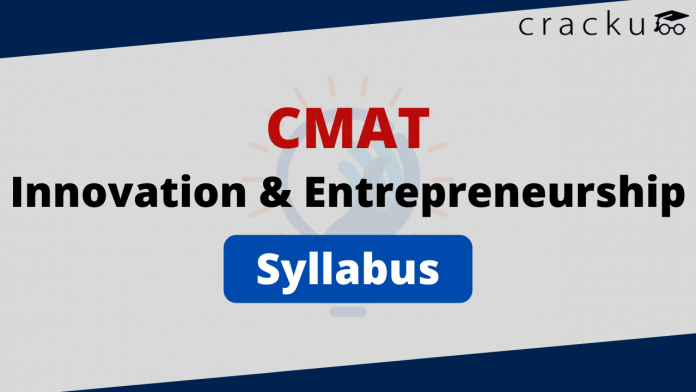CMAT 2022 Innovation and Entrepreneurship Syllabus
Common Management Admission Test (CMAT) is a National Level Entrance Examination for admission to Management Programs in the country. The CMAT 2022 exam registration has started. NTA has recently changed the exam pattern by adding a new section called the “Innovation and Entrepreneurship” section. In this article, we will discuss the CMAT Innovation and Entrepreneurship Syllabus in detail.
Get 5 CMAT Mocks – Just Rs. 299
Enroll to CMAT Crash Course for Just Rs. 1999
Exam Pattern
| Sections | No. of Questions | Maximum Marks |
| Quantitative Techniques and Data Interpretations | 20 | 80 |
| Logical Reasoning | 20 | 80 |
| Language Comprehension | 20 | 80 |
| General Awareness | 20 | 80 |
| Innovation & Entrepreneurship | 20 | 80 |
| Total | 100 | 400 |
In the new exam pattern including the new section, the number of questions for each section is also changed. Each section has 20 questions, and each question carries 4 marks and a negative marking of -1 for a wrong answer.
Syllabus for Innovation and Entrepreneurship
The primary purpose of adding this section to the CMAT Exam is to encourage the students who are willing to see themselves as entrepreneurs after completing their master’s degree. There will be 20 questions in this section, and each question carries four marks.
There is no particular syllabus for this section. Using the previous question papers of this section, we made a list of the most important topics that may help you crack this section. Innovation and Entrepreneurship are the two topics that are covered in this section.
Based on our analysis of the previous year’s (CMAT 2021) Paper, the questions in this section may come from different topics and different types of questions. The questions were primarily asked from three broad categories:
- General Knowledge based questions
- Reading Comprehension based questions (related to Innovation & Entrepreneurship)
- Questions related to the terminology about Innovation and Entrepreneurship.
What is innovation?
Innovation in an organisation refers to coming up with new ideas, the handling of all the activities needed to introduce something new, and implementing them. It’s all about developing an idea in NEW and ethical ways. Innovation also about approaching existing products or processes in new ways. There can be different types of innovation that an organisation might engage in (which are related to its business models, products, internal processes, workflows, etc.)
Key concepts to be considered in Innovation are given below.
- What is innovation management?
- The key aspects of innovation management (Capabilities, Structures, Strategy etc)
- Types of Innovation
- Innovator’s dilemma
- The technology adoption lifecycle
- Risk in innovation management, Risk of not improving
- The lifecycle of an innovation, Idea management systems, Product portfolio etc.
- What does successful innovation management look like?
- Strategies/processes such as Push vs. pull, the phase-gate process, the lean startup etc.
- KPIs – How to measure innovation? (Input metrics, Output metrics, Types of innovation metrics, Choosing the right metrics etc)
What is Entrepreneurship?
The process of setting up a startup/organisation is known as entrepreneurship. It is a process of bringing an idea to life. An entrepreneur is an individual who creates and develops a new business idea, takes the risks, and implements the idea. He/She looks for opportunities for development and finds solutions to the problems, working for a better future for the people. The entrepreneur is commonly seen as an innovator, a source of new ideas, goods, services, procedures, etc.
Key concepts to be considered in Entrepreneurship are given below.
- Definition of Entrepreneurship, and Who is an Entrepreneur?
- What is a Startup?
- State of Entrepreneurship in India.
- The legal structure for startups, Registration Process for entities. Business Licenses, Registrations and Agreements, Legal Contracts and agreements.
- Process of Entrepreneurship Development, business planning.
- Role of the Central and State Government in promoting Entrepreneurship.
- Role of Entrepreneur in the Indian economy.
- Entrepreneur Vs. Manager, Entrepreneur Vs. Intrapreneur.
- What do managers do and what managerial work includes.
- Environmental Analysis.
- Schemes are offered by various financial institutions to encourage entrepreneurs.
- Venture Capital Funding
- Elements of future growth
- Private Limited Company, Limited Liability Partnership, One Person Company (OPC)
- General Partnership Company and Sole Proprietorship.
- What is Idea generation, What is Idea Validation? and Methods to validate Idea.
- PEST Analysis, Market Research Activity.
- What is customer segmentation? and Types of customer segmentation.
- Buyer Persona.
- What is a Minimum Viable Product?
- What is the Business Model Canvas?
- What is Marketing? Traditional Vs Digital Marketing.
- Blue Ocean Strategy.
- Guerrilla Marketing.
- What is Business Finance? and Types of Financial Statements.
- Funding and Pitching: What is Funding, Types of Funding, What is Elevator Pitch? and so on.
Sample Questions
- Ru Pay has been launched by
Ans: National Payments Corporation of India
2. Entrepreneurs are risk
Ans: Takers
3. The conclusion part of the business plan will identify the
Ans: Feasibility of the business
Also, there will be a question that is nothing but an RC (Reading Comprehension). A Passage will be given and the questions will be asked from the passage.
Download CMAT Previous Papers PDF
Candidates can Join our Telegram group of MBA aspirants for quick and regular exam updates.




![CAT Averages Questions PDF [Important Questions] CAT AVERAGES Questions PDF](https://cracku.in/blog/wp-content/uploads/2022/07/CAT-AVERAGES-Questions-PDF-218x150.png)


